My kids ask me a lot of questions. Just this afternoon, they’ve wanted to know whether American Girl dolls are only for girls (of course not), which dinosaur is best (stegosaurus), where the Scotch tape is (I have no idea), and what the word flinch means (have you noticed that it’s surprisingly hard to give a good definition on the spot?).
I usually enjoy fielding my kids’ questions, and I take some pride in my role as Household Fount of Knowledge, but I also know this is a job with limitations. As my children get older, they’ll have bigger questions about climate change, or artificial intelligence, or how they can stand up for the people they love and the things they believe in. I won’t be able to provide all the answers on my own, and I might not always be the person they turn to for answers, either.
I will, however, have some excellent books to recommend. Titles like the ones coming out this month are the real Household Founts of Knowledge, helping young readers find answers to some of life’s huge and tiny mysteries: Is time travel possible? How will AI change society? Where does the wind come from? How can we protect our planet? Will my friends still love me when they realize I’m a spider?
*
Michelle Knudsen, Luigi, the Spider Who Wanted to Be a Kitten
illustrated by Kevin Hawkes
(Candlewick, March 5)
Recommended for ages 4-8
On my family’s toddler book tolerability index, Michelle Knudsen’s picture books consistently get top scores: they’re kid-friendly, well crafted, and a pleasure for adults to read aloud. All four of us were excited to hear that Knudsen and Kevin Hawkes, the author-illustrator team behind the beloved Library Lion, had teamed up again to create a new story. This one is about a charming (and big, and hairy) spider named Luigi and the kind lady who discovers Luigi under her sofa and seems to mistake him for a kitten. Plenty of delightful antics ensue, along with a little mild peril when Luigi realizes his feline cover’s been blown. Hawkes’ friendly, often funny illustrations give the whole book the feel of an instant classic. Like Library Lion and my absolute favorite Michelle Knudsen book, Marilyn’s Monster, this is a story I’ll be happy to read aloud for many years to come.
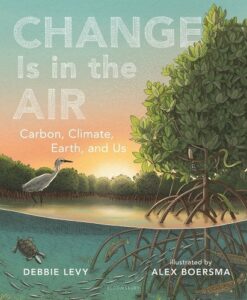
Debbie Levy, Change Is in the Air: Carbon, Climate, Earth, and Us
illustrated by Alex Boersma
(Bloomsbury, March 5)
Recommended for ages 4 and up
For many of us, being a parent of young kids means thinking a lot—and, okay, maybe panicking—about climate change. We don’t know exactly what the world will look like in the future, but we’d like to be able to discuss that future with our kids in age-appropriate, non-scary ways. Change Is in the Air might make some of those discussions a little easier. It’s a nonfiction picture book about our changing climate, written at a level that young children will understand and focused on possible solutions. The message is factual but hopeful: there’s too much carbon in the Earth’s air, but there are many things on Earth—including people—that can help. Both the text and the illustrations have lots of kid appeal, and I can imagine my own young readers sitting down to flip through this book for fun, picking up some crucial information about the state of our planet along the way.
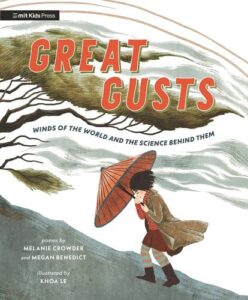
Melanie Crowder and Megan Benedict, Great Gusts: Winds of the World and the Science Behind Them
illustrated by Khoa Le
(MIT Kids Press, March 19)
Recommended for ages 6-9
Great Gusts is one of the most interesting books I’ve seen in a while for readers of any age. It’s a children’s science book about the wind, but it’s also a visually stunning picture book, and it’s also a poetry collection written by two poets with serious literary chops. Authors Melanie Crowder and Megan Benedict have created a series of playful, clever, and atmospheric poems about different winds around the world, from Libya’s ghibli to Antarctica’s katabatic. Some of the poems are written in traditional forms from the parts of the world where those winds originate, and all are accompanied by text that provides a few more facts for curious young scientists. The full-spread art by Khoa Le immerses readers in all sorts of different global landscapes, and each scene is so gorgeous that I’d like to wallpaper my house with pages from this book.
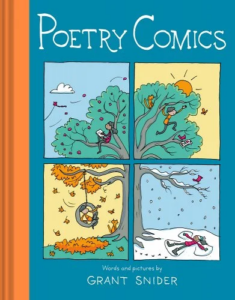
Grant Snider, Poetry Comics
Chronicle, March 26
Recommended for ages 8-12
If the young reader in your life is passionate about graphic novels and other highly illustrated adventures, they’ll fall head over heels for this extremely cool book, which presents poems in panel-style comic form. Author-illustrator Grant Snider captures a whole year’s worth of everyday childhood magic in these pages, with poems about static electricity superpowers, lost bicycles, playing basketball on a summer evening, and watching a tadpole grow into a frog. Each poetry comic is bite-sized enough to appeal to busy or reluctant readers, although it’s awfully hard to stop after reading just one. Teachers and homeschooling parents will be able to build fantastic lesson plans around this book, but it’s so much fun that I bet it’ll inspire lots of kids to write and illustrate their own poems outside the classroom, too.
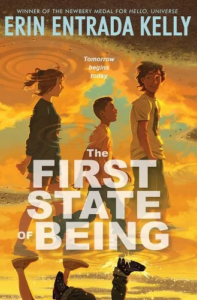
Erin Entrada Kelly, The First State of Being
HarperCollins, March 5
Recommended for ages 8-12
Newbery medalist Erin Entrada Kelly’s newest novel for middle grade readers is a foray into both speculative fiction (of the time-travel variety) and historical fiction (it’s set, dear readers, in 1999). Twelve-year-old Michael Rosario is worried about typical ’90s things: the impending Y2K disaster, his crush on his teenage babysitter, the canned peaches he shoplifted from the grocery store, and what to do about the kid named Ridge who just showed up in his housing complex claiming to be a time traveler from the year 2199. Meanwhile, two hundred years in the future, Ridge’s family is dismayed to find Ridge missing and their experimental spatial teleportation device broken. Kids will love the clever premise and wonderfully drawn characters, adults will appreciate the shoutouts to turn-of-the-century pop culture, and eagle-eyed readers might notice a nod to Rebecca Stead’s novel When You Reach Me.
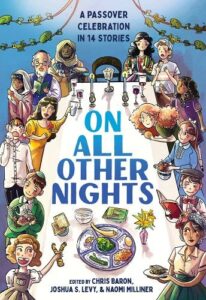
Chris Baron (editor), Joshua S. Levy (editor), Naomi Milliner (editor), On All Other Nights: A Passover Celebration in 14 Stories
(Abrams, March 26)
Recommended for ages 8-12
On All Other Nights begins with a question: “How is this anthology different from all other anthologies?” The answer, of course, is that it’s a collection of fourteen tales of Passover, each corresponding to a different step of the Seder, by fourteen critically acclaimed middle grade authors. The stories themselves are delightfully varied in form and tone, including a few memoirs, both contemporary and historical fiction, a story in verse, and even a tale about a mermaid. They also reflect the diverse backgrounds of the anthology’s authors: Mari Lowe’s protagonist is part of an Orthodox family, Veera Hiranandani’s heroine has a Hindu mother and Jewish father, and Ruth Behar writes about growing up in a Jewish and Cuban family with both Ashkenazi and Sephardic grandparents. The editors’ introductions and notes throughout the book ensure that readers from all backgrounds and faith traditions will feel welcome at this metaphorical Seder table. (Oh, and did I mention there are recipes? There are recipes!)
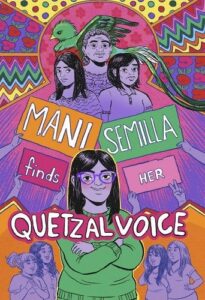
Anna Lapera, Mani Semilla Finds Her Quetzal Voice
(Levine Querido, March 5)
Recommended for ages 10-14
There’s a lot that seventh grader Manuela Semilla wants to talk about: How she’s longing to get her period. How she doesn’t want to go on a family trip to Guatemala. How the girls at her school are routinely harassed, treated unfairly, and then dismissed when they try to raise their concerns. Mani isn’t quite sure how to use the strong, confident “quetzal voice” her abuelita is always urging her to find, but when she learns about her Tía Beatriz’s efforts to stop violence against women in Guatemala, Mani realizes she has the power to do more than stay silent. And we readers are lucky to have her smart and funny voice to guide us. This impressive debut will make you laugh, cheer, and stand up on the nearest table to protest injustice, probably all before you finish chapter one.
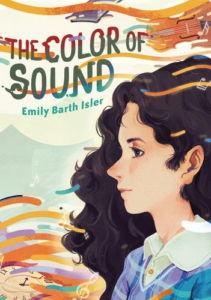
Emily Barth Isler, The Color of Sound
(Carolrhoda, March 5)
Recommended for ages 11-14
When I try to talk about this lyrical, inventive book, I get excited and a little flustered. “It’s about a twelve-year-old violin prodigy named Rosie!” I say. “And she’s got synesthesia—you know, she can see the colors and shapes of sounds? But she’s not playing the violin right now, and her mom is kind of overbearing, and the two of them don’t understand each other at all? And then Rosie goes out to the shed on her grandparents’ property and meets a girl who turns out to be her mom as a kid, but she hasn’t traveled back in time! It’s more of a magical outbuilding situation!” Somehow, elegantly, Emily Barth Isler weaves these disparate elements together into a truly original novel that explores family history and the complicated, ever-changing relationships between parents and children.
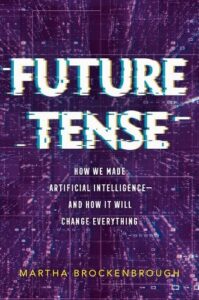
Martha Brockenbrough, Future Tense: How We Made Artificial Intelligence—and How It Will Change Everything
(Macmillan/Feiwel & Friends, March 19)
Recommended for ages 12-18
Martha Brockenbrough is a master of timely, thoroughly researched nonfiction for young people, and this accessible exploration of artificial intelligence is exactly the book that teen readers (and the rest of us) need right now. Future Tense provides an overview of the history of AI, from Aristotelian and Boolean logic all the way through major modern developments in computing and machine learning. It explains how AI has helped us in recent instances, like the COVID-19 pandemic; describes how AI might be used in the future, for better or worse; and helps readers ask smart questions about how all this innovation might affect their lives. You’ll learn a lot from Future Tense, but this isn’t a textbook. Brockenbrough explains complex concepts as if she’s talking to a friend, never lecturing to students or condescending to young people.
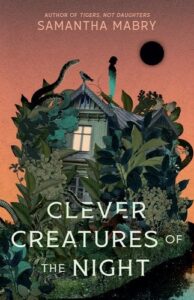
Samantha Mabry, Clever Creatures of the Night
Algonquin, March 5
Recommended for ages 14 and up
When it comes to horror novels, I prefer mine slow-burning, gorgeously written, and deliciously unsettling. Happily for me—and, I hope, for you—Samantha Mabry delivers on all those elements in Clever Creatures of the Night, about a teenager named Case who goes to visit her best friend, Drea, in remote and wooded West Texas. When Case reaches the house where Drea is supposed to be staying, she finds an odd clutch of roommates who refuse to tell Case where her friend has gone or what might have happened to her. The novel’s action spans only one day, but its sense of foreboding grows with each page turn, and teen and adult fans of literary horror will find this book tough to put down.
